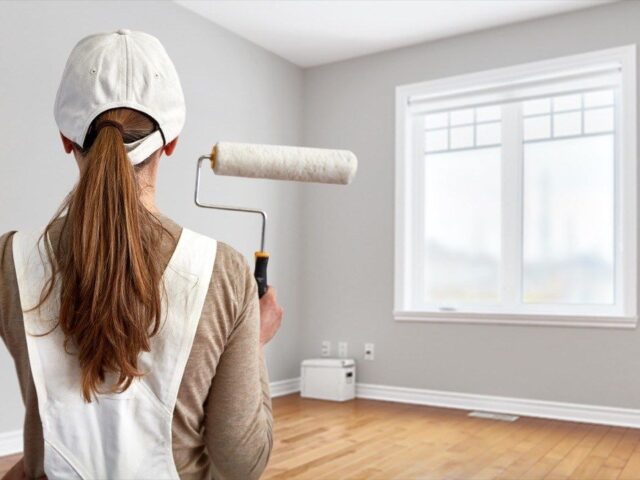High-Quality Lakewood Interior Painting to Enhance the Beauty of Your Space
Wiki Article
Elevate Your Living Environment Via Quality Shade Appointment
The relevance of shade in our living rooms expands beyond plain aesthetics; it profoundly affects our feelings and overall wellness. Engaging a professional shade specialist can change your setting, tailoring color pattern that resonate with your personality while enhancing performance and convenience. By recognizing the concepts of shade psychology and integrating experienced understandings, you can curate a harmonious atmosphere that mirrors your way of living. However, the journey to accomplishing this balance calls for careful consideration of different aspects-- what steps are necessary to ensure your color selections straighten with your vision?Comprehending Shade Psychology
Color psychology is regularly considered as a pivotal element in understanding human actions and emotions. The impact of shade extends past plain visual appeals; it can dramatically affect mood, understanding, and also decision-making processes. Each shade stimulates distinct emotional reactions based upon cultural context and individual experiences. Warm shades like red and orange tend to boost power and excitement, while trendy colors such as blue and environment-friendly are frequently associated with calmness and peace.In addition, the emotional effect of shade can differ across various atmospheres. In a work environment, for instance, blue colors might boost productivity and focus, while softer tones like off-white can advertise a feeling of convenience and relaxation. Conversely, extremely intense colors can bring about feelings of frustration or stress and anxiety.
Recognizing color psychology is vital for efficient color consultation, as it enables specialists to customize their suggestions to align with the designated psychological and functional objectives of an area. By thinking about private choices and emotional organizations, specialists can create unified atmospheres that promote health and boost overall lifestyle (Lakewood Interior Painting). This understanding offers as a foundational component in the art and science of color application in different setups
Advantages of Specialist Consultation

In addition, a specialist expert can assess your special living environment, thinking about elements such as all-natural light, room measurements, and existing home furnishings. This customized technique makes sure that color options balance with the general style, developing a cohesive look that may be hard to accomplish independently.
Time efficiency is another essential advantage. Professionals improve the decision-making procedure, assisting customers avoid the overwhelming variety of choices. They can likewise anticipate possible difficulties, such as shade clashes or undesirable effects, and supply remedies before execution.
Moreover, a professional consultation can increase the value of your residential property. Well-executed shade choices can elevate a room's charm, making it much more eye-catching to prospective customers. In summary, professional shade examination not only improves aesthetics however additionally enriches the living atmosphere and sustains notified decision-making.
Selecting the Right Color Design
Selecting the appropriate shade system is vital for accomplishing an unified and welcoming environment. Shades evoke feelings and established the tone for a space, affecting how individuals interact and perceive within it. When selecting a color pattern, take into consideration the purpose of the area, the wanted state of mind, and the existing building features.Begin by identifying a color scheme that reverberates with your vision. Popular options include monochromatic systems, which use varying shades of a solitary hue, and complementary plans, which pair shades from contrary sides of the shade wheel. Additionally, analogous schemes, including colors alongside each other, can produce a cohesive look.
It is important to examine colors Color Consultation in Lakewood in the actual room, as lights conditions can substantially modify their look. Paint examples on wall surfaces enables a real-world analysis of just how shades interact throughout the day. Additionally, consider the balance between neutral tones and bold colors to ensure aesthetic passion without frustrating the senses.
Ultimately, a well-balanced shade scheme can change a room, developing an environment that is not just cosmetically pleasing but comfortable and likewise practical for its passengers.
Integrating Shade With Style Components

Textiles play a critical duty in shade combination. Fabrics such as drapes, rugs, and upholstery must show the primary shade system, while additionally introducing additional shades to enhance the design. Layering appearances, such as combining smooth and rough surface areas, can enhance the shade's effect.
Accessories, including artwork, ornamental items, and plants, need to be selected to echo the color choices throughout the area. A well-curated plan can merge diverse aspects, guaranteeing that each item feels connected and deliberate. Consider the emotional effects of color; for example, greens and blues can advertise tranquility, while warm tones like reds and yellows can energize an area. Ultimately, the mindful combination of shade with design components boosts the living atmosphere, creating an area that is both aesthetically pleasing and functional.
Tips for Keeping Your Color Choices
Consistently examining and upgrading your shade choices is necessary for preserving a cohesive and lively layout. Begin by regularly evaluating the colors in your room against individual choices and current patterns. Take into consideration the emotional influence of your selected scheme; colors can stimulate various sensations and need to line up with the desired environment of each room.Following, make certain that your shades remain constant across various aspects of your layout. This consists of furniture, artwork, and devices. Lakewood Interior Painting. Blending way too many tones can cause aesthetic disorder, so select a color design that permits for versatility while still keeping unity
Make use of example boards or digital tools to envision just how shades engage with each other in various lights conditions. Bear in mind, natural light can considerably alter the assumption of shade.
Furthermore, don't shy away from tiny updates to refresh your area. Maintain a shade journal that notes your preferences over time; this will certainly assist in future assessments and guarantee your color selections stay pertinent.
Conclusion
In final thought, the assimilation of color psychology into living settings substantially enhances both visual charm and emotional health. By selecting ideal color plans and harmonizing them with style elements, a practical and well balanced area can be achieved.
Report this wiki page